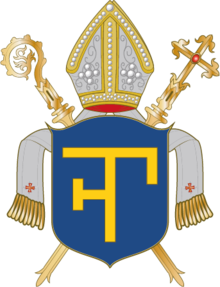
Back Kammin Azerbaijani Bisbat de Kammin Catalan Cammin bispedømme Danish Bistum Cammin German Diócesis de Cammin Spanish Diocèse de Cammin French Diocesi di Cammin Italian Prinsbisdom Cammin Dutch Cammin bispedømme NB Biskupstwo kamieńskie Polish
Roman Catholic Diocese of Cammin Dioecesis Caminensis Bistum Cammin (in German) | |
|---|---|
 Former Cathedral of St. John the Baptist, now Co-Cathedral in Kamień Pomorski | |
 Coat of arms | |
| Location | |
| Territory | most of ducal Pomerania, Stift territory, parts of eastern Mecklenburg, of the New March, and of the Uckermark |
| Ecclesiastical province | exempt |
| Information | |
| Denomination | Roman Catholic |
| Rite | Latin Rite |
| Established | 14 October 1140 de facto defunct since 1544 1688 former diocese subject to Nordic Missions Vicariate |
| Cathedral | Cammin in Pomerania: Cathedral of St. John the Baptist |
| Patron saint | Sabinus of Spoleto Faustinus of Brescia |
| Current leadership | |
| Bishop | last Catholic: Erasmus von Manteuffel |
Prince-Bishopric of Cammin Hochstift Cammina | |||||||||
|---|---|---|---|---|---|---|---|---|---|
| 1248–1650 | |||||||||
 Territory (violet) about 1250 | |||||||||
| Status | Vassal of Holy Roman Empire | ||||||||
| Capital | Wolin, see till ~1150 Usedom Abbey, see till 1175 then Cammin, see & chapter Kolberg, bishop's residence as of 1276 Köslin, Stift government | ||||||||
| Common languages | Official: German Unofficial: Pomeranian, Kashubian | ||||||||
| Religion | Catholic till 1544, then Lutheran | ||||||||
| Government | elective monarchy, ruled by the prince-bishop or administrator holding the see, elected by the chapter or, exceptionally, appointed by the Pope | ||||||||
| Prince-bishop, administrator, or chapter (in vacancy) | |||||||||
• 1394–1398 | Prince-Bishop John III | ||||||||
• 1479 | Prince-Bishop Nicolaus | ||||||||
• 1574–1602 | Administrator Casimir | ||||||||
• 1637–1650 | Admin. Ernest Bogislaw | ||||||||
| Legislature | bishop, chapter and Stift estates | ||||||||
| Historical era | High Middle Ages to Early modern period | ||||||||
• Cammin Diocese est. | 1140 | ||||||||
• Bishop gained rule in temporalities near Kolberg | 1248 | ||||||||
• acquired imperial immediacy | 1345, 1417 (conf.) | ||||||||
• joined Upper Saxon Circle | 1512 | ||||||||
• immediacy confirmed | 1521, and 1542 | ||||||||
• autonomy waived, Pomeranian fief | 1544 | ||||||||
• seized by Brandenburg | 1650 | ||||||||
• merged in Pomerania Province | 1653 | ||||||||
| |||||||||
| Today part of | Poland | ||||||||
The Bishopric of Cammin (also Kammin, Kamień Pomorski) was both a former Roman Catholic diocese in the Duchy of Pomerania from 1140 to 1544,[2] and a secular territory of the Holy Roman Empire (Prince-Bishopric) in the Kołobrzeg area from 1248 to 1650.
The diocese comprised the areas controlled by the House of Pomerania in the 12th century, thus differing from the later territory of the Duchy of Pomerania by the exclusion of the Principality of Rügen and inclusion of Circipania, Mecklenburg-Strelitz, and the northern Uckermark and New March. The diocese was rooted in the Conversion of Pomerania by Otto of Bamberg in 1124 and 1128 at the behest of Polish ruler Bolesław III Wrymouth,[3] and was dissolved during the Protestant Reformation, when the Pomeranian nobility adopted Lutheranism in 1534 and the last pre-reformatory bishop died in 1544. The Catholic diocese was succeeded by the Pomeranian Evangelical Church and suppressed until 1945, when its new incarnation, the Apostolic Administration of Kamień, Lubusz and the Prelature of Piła was re-established, succeeded by the Diocese of Szczecin-Kamień in 1972, elevated to Archdiocese of Szczecin-Kamień in 1992.
From west to east, the diocese bordered the dioceses of Schwerin, Havelberg, Brandenburg, Lubusz, Poznań, Gniezno and Włocławek.
The cathedral complex in Kamień Pomorski is listed as a Historic Monument of Poland.[4]
- ^ Gerhard Köbler, Historisches Lexikon der Deutschen Länder: die deutschen Territorien vom Mittelalter bis zur Gegenwart, 7th edition, Munich: C.H.Beck, 2007, p. 113, ISBN 3-406-54986-1.
- ^ Diocese of Cammin, Germany Archived 4 February 2014 at the Wayback Machine
- ^ Medley, D. J. (2004). The church and the empire. Kessinger Publishing. p. 152.
- ^ Rozporządzenie Prezydenta Rzeczypospolitej Polskiej z dnia 25 sierpnia 2005 r. w sprawie uznania za pomnik historii "Kamień Pomorski - zespół katedralny", Dz. U., 2005, vol. 167, No. 1401
